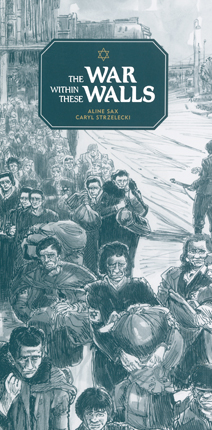Full Text Reviews: School Library Journal - 10/01/2013 Gr 8 Up—Told from the point of view of a Jewish teen, this short, illustrated novel begins with the invasion of Poland in 1939 and goes on to describe the limits placed on the Jewish population and their eventual incarceration in the Warsaw Ghetto. The narrator describes the daily humiliations, depravations, despair, and deaths at the hands of the Nazis. When his family runs out of food, the narrator descends into the sewer system to cross to the Polish side of the Ghetto walls, where he is able to buy or steal food. When the Nazis employ flame throwers to kill those in the sewers, he loses his nerve. Unfortunately, he isn't able to stop his younger sister from traveling the sewers, and one day she doesn't return. When it becomes clear that everyone in the Ghetto is going to be resettled in the East, the narrator is ready, when approached by Mordechai Anielewicz, one of the actual leaders of the uprising, to join the resistance. The last portion of the book describes the Warsaw Ghetto Uprising from the narrator's point of view. The pen, ink, and pencil artwork serves to extend and clarify the story. The combination of the illustrations and the author's spare prose make this a good choice for reluctant readers and an outstanding example of Holocaust fiction.—Nancy Silverrod, San Francisco Public Library - Copyright 2013 Publishers Weekly, Library Journal and/or School Library Journal used with permission. Bulletin for the Center... - 01/01/2014 In this fictional memoir, a young Jewish man known only as Misha recounts his experience in Warsaw from the German invasion of 1939 through the Warsaw Ghetto Uprising of spring, 1943. “I had never felt so Jewish before,” Misha remarks as relocated Jews are crammed into his city, and he initially regards them more with resentment than sympathy: “Like dirty water, they kept pouring into the mouth and nostrils of the ghetto. Until it would be impossible for us to breathe.” Food supplies dwindle and when Misha’s sister is lost in one of their nighttime raids, he despairs of saving his starving parents on his own. When deportations begin in 1942, and rumors of the true fate of deportees circulate throughout the ghetto, Misha is primed to take any risk, so when a man introduces himself as Mordechai Anielewicz and urges Misha to join the armed resistance, he’s ready and willing. Misha’s narration is tense and terse, his clipped sentences pared down to the pinched poetry of a man whose worldview has become as emaciated as the bodies of his neighbors. The book design underscores this reduction to elemental needs, with slate-blue text on cream background sporadically switching to a stark word or phrase of simple cream on blue with startling effect. Strzelecki’s ink and pencil illustrations, also in deep slate and gray, recall woodcuts, depicting both moments of private sorrow and public violence. This translation from Sax’s original Dutch will be a powerful addition to the Holocaust collection in high school libraries. An historical note on the real Mordechai Anielewicz is appended. EB - Copyright 2014 The Board of Trustees of the University of Illinois. Loading...
|



